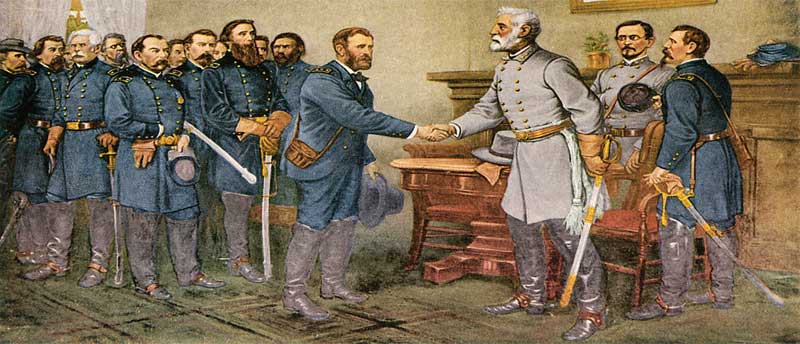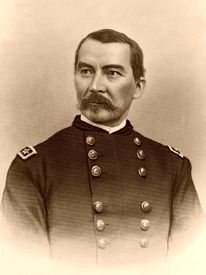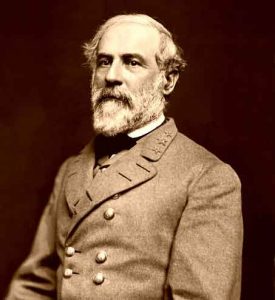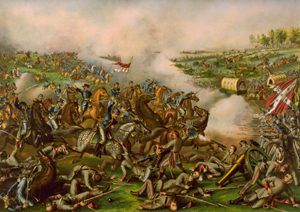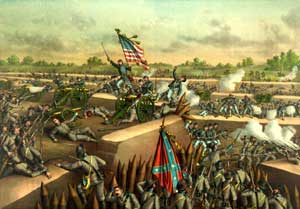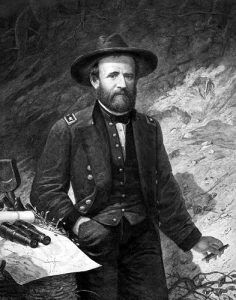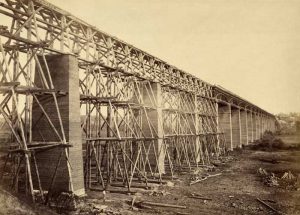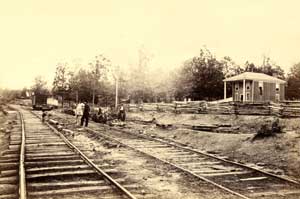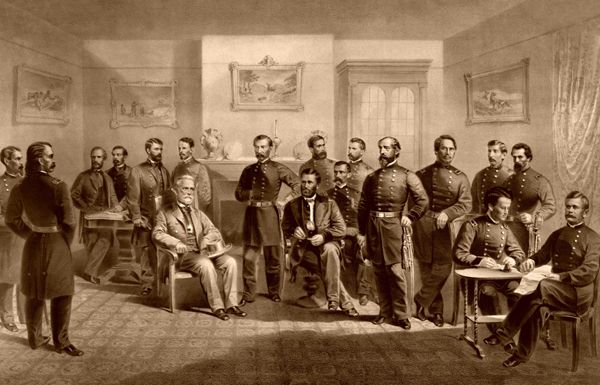Nations, like individuals, are punished for their transgressions. We got our punishment in the most sanguinary and expensive war of modern times.
— Ulysses S. Grant
The Appomattox Campaign of the Civil War was a series of battles fought March 29-April 9, 1865, in Virginia that culminated in the surrender of Confederate General Robert E. Lee’s Army of Northern Virginia and the effective end of the Civil War.
Battles
Lewis’ Farm (March 29, 1865) – Also known as the Battle of Quaker Road, Military Road, and Gravelly Road, this engagement occurred in Dinwiddie County. On March 29, in the opening moves of Lieutenant General Ulysses S. Grant’s spring offensive, General Philip Sheridan marched with the army’s cavalry, followed by the V Corps toward Dinwiddie Court House to turn the right flank of Confederate General Robert E. Lee’s Petersburg defenses. Under Major General G.K. Warren, the Union V Corps crossed Rowanty Creek, moved up the Quaker Road toward the Boydton Plank Road intersection, and encountered Major General Bushrod Johnson’s Confederate brigades. A sharp firefight forced the Confederates back to their entrenchments on the White Oak Road. The Union victory resulted in estimated casualties of 380 Union and 370 Confederate.
White Oak Road (March 31, 1865) – Known by several other names, including the Battles of Hatcher’s Run, Gravelly Run, Boydton Plank Road, and White Oak Ridge, this engagement occurred in Dinwiddie County. On March 30, Confederate General Robert E. Lee shifted reinforcements to meet the Federal movement to turn his right flank, placing Major General W.H. Fitzhugh Lee’s cavalry divisions at Five Forks and transferring General George Pickett’s division from the Bermuda Hundred front to the extreme right. Union Major General G.K. Warren pushed the V Corps forward and entrenched a line to cover the Boydton Plank Road from its intersection with Dabney Mill Road south to Gravelly Run. Union Major General Romeyn B. Ayres’ division advanced northwest toward White Oak Road. On March 31, in combination with Major General Philip Sheridan’s thrust via Dinwiddie Court House, General Warren directed his corps against the Confederate entrenchments along White Oak Road, hoping to cut Lee’s communications with Pickett at Five Forks. The Union advance was stalled by a crushing counterattack directed by Major General Bushrod Johnson, but Warren’s position stabilized, and his soldiers closed on the road by day’s end. This fighting set up the Confederate defeat at Five Forks on April 1. The engagement resulted in estimated casualties of 1,870 Union and 800 Confederate.
Dinwiddie Court House (March 31, 1865) – In Dinwiddie County, Major General Philip Sheridan undertook a flank march to turn Confederate General Robert E. Lee’s Petersburg defenses on March 29. A steady downpour turned the roads to mud, slowing the advance. On March 31, Confederate Major General W.H. Fitzhugh Lee’s cavalry and General George Pickett’s infantry division met the Union vanguard north and northwest of Dinwiddie Court House. They drove it back, temporarily stalling Sheridan’s movement. With Union infantry approaching from the east, Pickett withdrew before daybreak to entrench at the vital road junction at Five Forks. Lee ordered Pickett to hold this intersection at all hazards. The Confederate victory resulted in a total estimated 821 casualties.
Five Forks (April 1, 1865) – The fighting continued in Dinwiddie County when Confederate General Robert E. Lee ordered Generals George Pickett, General Thomas Munford, Fitzhugh Lee, and Thomas Rosser to hold the vital crossroads of Five Forks at all hazard. On April 1, while Union General Philip Sheridan’s cavalry pinned the Confederate force in position, the V Corps under Major General G.K. Warren attacked and overwhelmed the Confederate left flank, taking many prisoners. Sheridan personally directed the attack, which extended General Robert E. Lee’s Petersburg lines to the breaking point. Loss of Five Forks threatened Lee’s last supply line, the South Side Railroad. General Lee informed Confederate President Jefferson Davis that Petersburg and Richmond must be evacuated the following day.
Union General Frederick Winthrop was killed, and “Willie” Pegram, a beloved Confederate artillery officer, was mortally wounded. Dissatisfied with his performance at Five Forks, General Sheridan relieved Warren of command of the V Corps. The Union victory resulted in an estimated 830 Union and 2,950 Confederate casualties.
Petersburg III (April 2, 1865) – With the Confederate defeat at Five Forks the previous day, Lieutenant General Ulysses S. Grant and Major General George G. Meade ordered a general assault against the Petersburg lines by II IX, VI, and XXIV Corps on April 2. A heroic defense of Fort Gregg by a handful of Confederates prevented the Federals from entering the city that night. Confederate Lieutenant General A.P. Hill was killed trying to reach his troops in confusion. After dark, General Lee ordered the evacuation of Petersburg and Richmond. General Grant had achieved one of the primary military objectives of the war: the capture of Petersburg, which led to the fall of Richmond, the Capitol of the Confederacy. The Union victory resulted in estimated casualties of 3,500 Union and 4,250 Confederate.
Sutherland’s Station (April 2, 1865) – On the same day as the Third Battle of Petersburg, Major General Nelson A. Miles traveled north from White Oak Road in Dinwiddie County. General miles met elements of four Confederate brigades under Generals John Cooke, Alfred Scales, Dandridge MacRae, and Samuel McGowan attempting to defend the South Side Railroad. The Confederates placed their left flank on Ocran Methodist Church, where it was overrun by three Union brigades commanded by General Miles. The Confederate defenders were scattered and driven northwestward. With this victory, the Federals possessed the South Side Railroad, General Robert E. Lee’s last supply line into Petersburg. The Union victory resulted in estimated casualties of 370 Union and 600 Confederate.
Namozine Church (April 3, 1865) – This rearguard cavalry action took place in Amelia County when a brigade of Union cavalry under Colonel William Well’s attacked General Fitzhugh Lee’s cavalry near Namozine Church on April 3. Confederate General Rufus Barringer was captured nearby. The inconclusive battle resulted in total estimated casualties of 75.
Amelia Springs (April 5, 1865) – Confederate cavalry under Generals Fitzhugh Lee and Tomas Rosser assaulted the Union cavalry under General George Crook as they returned from burning Confederate wagons at Painesville. This running fight started north of Amelia Springs and pushed through and beyond Jetersville. The inconclusive battle resulted in total estimated casualties of 250.
Sailor’s Creek (April 6, 1865) – Also known as Sayler’s Creek, Hillsman Farm, or Lockett Farm, this engagement occurred southwest of Petersburg, Virginia. It was the last significant engagement between the armies of General Robert E. Lee and Lieutenant General Ulysses S. Grant before the capitulation of Lee’s Confederate army at Appomattox Court House three days later. On April 6 at Sayler’s Creek, nearly one-fourth of the retreating Confederate army was cut off by Major General Philip Sheridan’s Cavalry and the II and VI Corps elements. Most surrendered, including Confederate Generals Richard S. Ewell, Seth, Barton, James Simms, Joseph Kershaw, Custis Lee, Dudley Du Bose, Eppa Hunton, and Montgomery Corse. This action was considered the death knell of the Confederate army. Upon seeing the survivors streaming along the road, General Robert E. Lee exclaimed: “My God, has the army dissolved?” The Union victory resulted in total estimated casualties of 9,980.
“We were attacked… front and rear by overwhelming numbers; the battle degenerated into a confused melee of brutal personal conflicts.”
Major Robert Stiles, Richmond Howitzers, Army of Northern Virginia, C.S.A., recalling the fighting at Sailor’s Creek, April 6, 1865
Rice’s Station (April 6, 1865) – Also Called the Battle of Rice’s Depot, General James Longstreet’s command reached Rice’s Station in Prince Edward County on April 6 but found it blocked by Union XXIV Corps. After some skirmishing, Longstreet withdrew over the High Bridge during the night toward Farmville. The Union victory resulted in only a few total casualties.
Cumberland Church (April 7, 1865) – Also called the Battle of Farmville, this engagement occurred in Cumberland County. Near 2 pm on April 7, the advance of the Union II Corps encountered Confederate forces entrenched on high ground near Cumberland Church. The Union forces attacked twice but were repulsed, and darkness halted the conflict. Union General Thomas Smythe was mortally wounded nearby, and Union General John Gregg was captured north of Farmville. The Confederate victory resulted in estimated casualties of 655 Union and 255 Confederate.
High Bridge (April 6-7, 1865) – With the Civil War in its final days, this engagement was fought in Prince Edward and Cumberland Counties. On April 6, the Confederate cavalry fought stubbornly to secure the Appomattox River bridges. Confederate General James Dearing was mortally wounded. On April 7, elements of the II Corps came up against Confederate General James Longstreet’s rearguard, attempting to fire the High Bridge and wagon bridge. Union forces could save the wagon bridge over which the II Corps crossed to pursue General Lee’s army. Failure to destroy this bridge enabled Union forces to catch up with the Confederates at Farmville. The inconclusive battle resulted in a total estimated 1,200 casualties. Of these, some 800 Union soldiers were captured.
Appomattox Station (April 8, 1865) – Major General George A. Custer’s division captured a supply train and 25 guns, driving off and scattering the Confederate defenders. This unique action pitted artillery without infantry support against cavalry. Custer captured and burned three trains loaded with provisions for Lee’s army. The number of casualties in the Union victory is unknown.
Appomattox Court House (April 9, 1865) – Early on April 9, the remnants of General John Broun Gordon’s corps and General Fitzhugh Lee’s cavalry formed a line of battle at Appomattox Court House. General Robert E. Lee determined to make one last attempt to escape the closing Union pincers and reach his supplies at Lynchburg. At dawn, the Confederates advanced, initially gaining ground against General Philip Sheridan’s cavalry. However, the arrival of Union infantry stopped the advance in its tracks. The Confederate army was now surrounded on three sides, and General Robert E. Lee surrendered to Lieutenant General Ulysses S. Grant. This was the final engagement of the war in Virginia. The Union victory resulted in an estimated 700 total casualties, and 27,805 Confederate soldiers were paroled.
More Information:
Appomattox Court House National Historical Park
Hwy. 24, P.O. Box 218
Appomattox, Virginia 24522
434-352-8987 x 226
Compiled and edited by Kathy Alexander/Legends of America, updated December 2021.
Also See:
Appomattox Court House National Historical Park, Virginia
Civil War Campaigns of Virginia
Eastern Theater of the Civil War
Battle summary information courtesy of the American Battlefield Protection Program. Summaries were researched and written by Dale E. Floyd and David W. Lowe, Civil War Sites Advisory Commission staff members and historians with the National Park Service.

